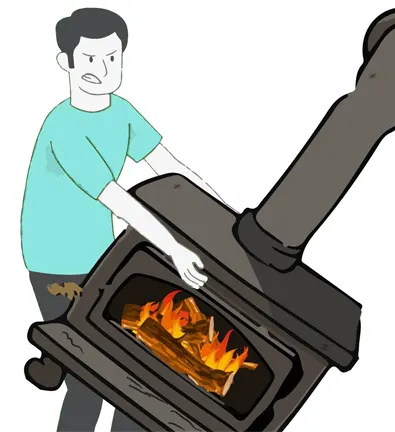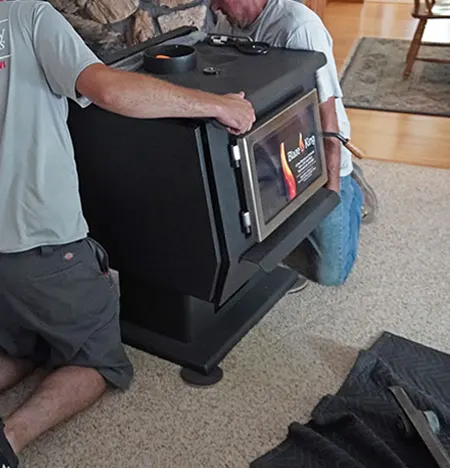How to Move a Wood Stove Safely and Securely
- November 15, 2023
- 0 comment
Moving a wood stove is a task that combines the complexity of a delicate operation with the physical demands of heavy lifting. It’s not just about having the muscle; it’s about understanding the right techniques to protect both the stove and your surroundings. Whether you’re rearranging your home or relocating, understanding how to move a wood stove safely and securely is crucial.
Why Move a Woodstove?

One common reason is a change in the home’s layout or design. Perhaps you’re remodeling, or you simply desire a change in your living space, necessitating the relocation of your wood stove. In such cases, it’s important to ensure the new location is well-suited for the stove, considering factors like proper ventilation, efficient heat distribution, and overall safety.
Another reason for moving a woodstove is to facilitate easier cleaning. Regular maintenance is crucial for the efficient and safe operation of woodstoves. Over time, they accumulate ash and creosote, which can pose a fire hazard if not regularly cleaned. By relocating the stove to a more accessible area, the cleaning process becomes less cumbersome, thus promoting better upkeep and safety.
Lastly, relocating to a new home can be a motive to move your woodstove. If you’re attached to your current stove, perhaps for its quality or sentimental value, you might consider taking it with you. This decision requires careful consideration of the new home’s layout, ensuring proper installation, and adherence to local building codes and safety regulations. Additionally, the logistics of transporting such a heavy and bulky item safely should be thoroughly planned.
In each scenario, the move must be well-planned and executed with caution, prioritizing the stove’s safe handling and transportation and the suitability and preparedness of its new location.
Preparing for the Wood Stove Relocation
Preparing for the move of a wood stove involves several critical steps to ensure safety and efficiency throughout the process:

- Safety First: The initial step is to assess whether you have the necessary manpower and appropriate tools for the job. Moving a wood stove is not a task that can be handled by one person alone, given its weight and the complexities involved. While a DIY approach is a possibility, the safer and often more efficient option is to enlist the services of professional movers. These professionals are not only experienced but also equipped with the strength and specialized tools needed for such a heavy and delicate task.
- Clear a Path: The next step is ensuring a clear path from the stove’s current location to its new location or to the moving vehicle. This task goes beyond simply clearing the floor space. It involves removing furniture, rolling up rugs, and sometimes even taking doors off their hinges to provide enough space. Every part of the route, including corners, narrow passageways, and staircases, should be taken into account. The goal is to create a path that is as direct and free from obstacles as possible, minimizing the risk of accidents or damage during the move.
- Plywood Pathway: If the move does not involve using a dolly, laying down sheets of plywood along the route is a critical step. This is particularly crucial for homes with hardwood or tiled floors, which are susceptible to scratches or cracks under the heavy load and movement of the stove. Plywood not only serves to protect the flooring but also creates a smoother surface, facilitating easier sliding of the stove. This setup can significantly reduce the physical effort required and assist in maneuvering the stove with greater precision and control.
7 Steps for Secure Wood Stove Moving
Successfully relocating a wood stove requires careful planning and execution. Follow these seven essential steps on How to Relocate a Wood Stove Safely to ensure a smooth and hazard-free move:
- Assemble a Team: Gather a team of at least three capable individuals to help with the heavy lifting and maneuvering of the stove. It’s important to choose people who are physically able to handle the task. Communicate clearly with your team about the plan and each person’s role to ensure coordination during the move.
- Remove Accessories: Detach any removable parts like stove pipes and doors to make the stove lighter and reduce the risk of damage to these components. Label each part and keep the corresponding screws and hardware in marked bags for easy reassembly.
- Wrap for Transport: If the stove is being transported in a vehicle, wrap it securely in furniture blankets to prevent scratches or damage. Use sturdy straps to secure the wrapping and ensure the stove is immobile. Double-check that all parts are covered and that the corners and edges have extra padding.
- Proper Lifting Techniques: Use your legs, not your back, to lift the stove onto a dolly or plywood. It’s wise to have someone guide the process and ensure that everyone is lifting in unison to maintain balance and prevent strain or injury.
- Steady Transportation: Keep the stove balanced on the dolly, paying special attention to uneven surfaces or ramps. Assign one person to monitor the stability of the stove at all times during the move to quickly address any shifting.
- Reassembly at Destination: Once at the new location, carefully reattach all parts that were removed. Double-check all connections and fittings to ensure they are tight and secure. This is also a good time to perform any routine maintenance or cleaning that might be easier with the stove disassembled.
- Reverse the Process for Unloading: When unloading and positioning the stove in its new spot, reverse the steps taken during loading. Move slowly and methodically, ensuring that the path is clear and that each team member knows their role in the process. Once in place, do a final inspection to ensure the stove is level and properly positioned.
Additional Safe Wood Stove Moving Tips:
- Understand the full weight of your stove to determine the necessary manpower and tools.
- Check that the stove fits through all doorways, hallways, and passageways in your home to avoid unexpected challenges.
- Plan a clear path for moving the stove, and removing any furniture, decorations, or obstacles that could impede movement.
- Cover the stove with protective materials to prevent damage, especially important for parts like glass or delicate finishes.
- If connected to a gas line, turn off the gas at the shutoff valve to prevent leaks or hazardous situations.
- Fasten or securely pack all movable parts, such as doors and glass panels, to prevent them from opening or breaking during the move.
- Have an alternative moving plan in case of obstacles or issues with the initial route.
- Remove all ashes and debris from the stove to make it lighter and reduce potential mess.
- Lay down blankets, cardboard, or plywood to protect your flooring from scratches or damage during the move.
- Be aware of local regulations concerning the moving of wood stoves, as some areas may have specific rules, especially regarding appliances that contain combustible residues.
DIY vs. Hiring Professionals
When deciding between a DIY approach and hiring professionals to move a wood stove, there are a couple of key factors to consider.

Firstly, the cost is an important consideration. Professional movers typically charge around $25 to $50 per hour, which can add up depending on the complexity and duration of the move. While opting for a DIY approach can save money, it’s essential to weigh this against the potential risks involved. These risks include personal injury due to the heavy lifting and maneuvering involved, as well as the possibility of damaging floors or other parts of your home during the move.
Another critical factor is the skill and equipment required for such a task. Professional movers not only bring their physical strength to the job but also come equipped with the right tools and experience. This expertise significantly reduces the risk of accidents and ensures that the stove is moved safely and efficiently. They know how to navigate tight spaces, handle heavy objects without causing damage, and secure the stove properly for transportation.
In summary, while a DIY move might be more cost-effective, the benefits of hiring professionals – including their expertise, proper equipment, and reduced risk of injury or property damage – can often outweigh the savings. It’s a decision that requires careful consideration of the specific circumstances and personal comfort with the risks involved in moving such a heavy and complex item.
Legal and Safety Concerns
Combustible Materials
When transporting a wood stove, it’s crucial to be aware of and comply with the legal restrictions concerning the movement of combustible materials, as these vary by region. Wood stoves, designed to contain and manage fire, fall under this category, making their transport subject to specific regulations. Additionally, certain weather conditions, such as extreme dryness or high winds, can significantly increase the risks associated with moving combustible items like wood stoves.
In such scenarios, the fire hazard potential is heightened, demanding extra caution and adherence to any regional advisories or restrictions in place. To ensure safe transport, it’s advisable to check the weather forecast and plan the move for a day with favorable conditions. Furthermore, staying informed about local laws and obtaining necessary permits can prevent legal issues and enhance safety during transportation.
Transportation Safety
Transporting a wood stove safely over long distances requires meticulous attention to securing it properly within the vehicle. The primary goal is to ensure the stove remains stable and immobile throughout the journey, as any movement or tipping could not only damage the stove but also the vehicle, potentially leading to accidents. Using the appropriate equipment is crucial in this regard. Straps and padding are essential tools for this task, helping to keep the stove firmly in place and cushioning it against any impacts or vibrations encountered during transit.
Additionally, choosing a vehicle that is adequately sized and strong enough to handle the weight and dimensions of the stove is important. It’s also advisable to regularly check the security of the stove at intervals during the journey, adjusting straps and padding as necessary to maintain stability. By following these guidelines, the risks of damage and accidents can be significantly minimized, ensuring a safe transportation process for your wood stove.
Conclusion
Moving a wood stove is a challenging but achievable task. Whether you opt for DIY or professional help, understanding the steps and safety precautions is key to a successful move. Remember to always prioritize safety, plan meticulously, and never underestimate the complexity of moving such a hefty appliance. With proper preparation and execution, your wood stove can be relocated without a hitch.
FAQs
- Can I dismantle my wood stove for easier transportation?
Yes, dismantling certain parts of your wood stove, like the pipes and doors, can make it easier and safer to transport. However, ensure you keep track of all parts and understand how to reassemble them correctly. - What should I do if my wood stove has a built-in blower or electrical components?
If your wood stove has a blower or any electrical components, make sure to disconnect them safely before moving. Consult the manufacturer’s manual for specific instructions on handling these parts. - How do I protect my wood stove’s glass during the move?
Protect any glass components by wrapping the stove in furniture blankets and securing them with straps. You might also consider using bubble wrap or a similar protective material for added cushioning. - Is it necessary to cool down the wood stove completely before moving it?
Absolutely. The stove should be completely cool before you start the moving process. This not only ensures safety but also prevents any risk of fire hazards. - Can I use a regular dolly to move my wood stove, or do I need something more specialized?
While a regular dolly can be used for some smaller stoves, heavier models might require an appliance dolly or a furniture dolly with a higher weight capacity. Ensure the dolly is sturdy enough to handle the stove’s weight. - How do I manage to move the wood stove upstairs or downstairs?
Moving a wood stove up or down stairs requires extra caution. Use a dolly, and have multiple people to help guide and stabilize the stove. Consider using moving straps for better control. - What are some common mistakes to avoid when moving a wood stove?
Common mistakes include underestimating the stove’s weight, not securing loose parts, inadequate floor protection, and not planning a clear path. Avoid these to ensure a safe move. - Should I notify my home insurance provider about moving my wood stove?
Yes, it’s a good practice to inform your home insurance provider when moving large appliances like a wood stove, as it may affect your coverage or liabilities. - How long should I wait before using the wood stove in its new location?
After reassembling and installing the stove in its new location, it’s advisable to wait at least 24 hours before using it. This ensures everything is set and any connections or installations are secure. - What are the signs that I should leave moving my wood stove to the professionals?
If the stove is extremely heavy, located in a difficult-to-access area, or if you lack the necessary equipment and manpower, it’s best to hire professional movers. Additionally, if you’re unsure about safely disconnecting and reconnecting the stove, professional assistance is recommended.
Got your wood stove moved or planning to do so? We’d love to hear how it went! Share your stories or any tips you might have in the comments below. Your insights could be a big help to others looking to tackle this task safely and successfully. Let’s help each other out and keep the warmth spreading!

David Murray
Forestry AuthorI'm David Murry, a forestry equipment specialist with a focus on chainsaw operation. With over 13 years of experience, I've honed my skills in operating and maintaining a wide range of machinery, from chainsaws to log splitters. My passion for the outdoors and commitment to sustainable forestry drive my work, which emphasizes safety, efficiency, and staying updated with industry advancements. Additionally, I'm dedicated to sharing my expertise and promoting environmental awareness within the forestry community.













Leave your comment